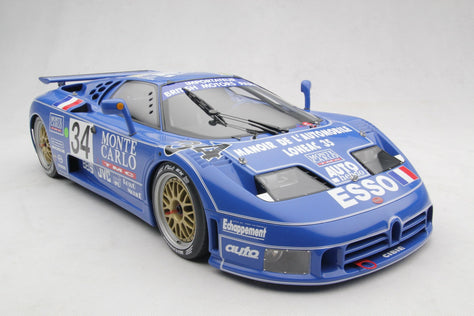Technische Einzelheiten
- Beschreibung
- Skalen-Leitfaden
Powered by Honda’s third engine configuration in just four seasons, the MP4/6 appeared somewhat of a gamble for McLaren before the 1991 season. The new V12 unit was longer, heavier and thirstier than the V10s which powered many of McLaren’s rivals, but it was hoped that the output of around 720 bhp would compensate for it. During engine testing, when using the MP4/5C chassis, it failed to convince reigning world champion Ayrton Senna who was quick to tell the Japanese engineers what he thought of it in his usual candid terms. The Japanese stuck to their guns however, claiming that Honda engines are made for reliability rather than power. With the benefit of hindsight, they were right. Senna and McLaren made a flying start to the season: four victories in the opening four races, whilst his team-mate Gerhard Berger achieved two podiums. The increased engine weight was being partly offset by the latest development of McLaren’s six-speed gearbox.
The car itself, whilst looking similar to the previous year’s MP4/5B, was quite different in terms of its aerodynamic profile as designer Neil Oatley and his team had received some valuable input from Henri Durand who had joined from Ferrari in mid-1990. Numerous changes had to be made to the chassis, not least in order to accommodate the longer engine and the enlarged fuel cell needed to satisfy its greater thirst. Even with four centimetres added to its length, the new tub was much stiffer in terms of torsional rigidity and consisted of even fewer basic components than before. There were changes to the suspension too, an aspect of the car which had altered dramatically since the year before, with pushrod-activated coil-spring dampers now mounted on top of the chassis ahead of the cockpit instead of being installed vertically either side of the footwell.
Senna’s perfect start had given McLaren a comfortable lead in the constructors’ championship and the margin gained was to prove crucially important as the team's performance began to slip. A double retirement in Montreal gave the team a reality check, whilst their closest rivals Williams-Renault began to gather pace as their V10 power unit’s reliability improved. The increased fuel consumption of the Honda V12 posed challenges of its own. Despite plenty of development on the engine management system, Senna ran out of fuel twice during the season, at Silverstone on the way back to the pits and at Hockenheim on the final lap. After the German Grand Prix, Williams snuck ahead of McLaren, leading the way by one point. Undeterred, Honda continued developing its V12, improving mid-range punch and reducing friction problems with new specs through the season. New linked rocker arms were also employed in a bid to reduce roll, and a cockpit-adjustable ride-height mechanism was also added.
In Budapest, the MP4/6 regained its form in the nick of time, as Senna claimed victory with a fine drive, ending a five-race winless streak. At the following race at Spa, despite suffering a gearbox failure, he was victorious once again, leading Berger in a 1-2 finish. However, their rivals responded, commanding the field in both the Portuguese and Spanish races, the last of which saw Senna struggling on the wrong tyres, retaking the lead in the championship. At the penultimate race in Suzuka, Berger scored his sole victory of the season, and his first for McLaren, having been handed victory by Senna in another one-two finish. This left Senna in an unassailable position on 96 points, winning his third and last title, while Berger finished fourth with 43 points. McLaren sealed the championship in the final race of the season, at a torrentially rain-soaked Australian Grand Prix which was forced to conclude after 14 laps.
Overall, the MP4/6 scored eight wins, 11 further podiums, 10 pole positions, five fastest laps, and 139 points, earning Senna the Drivers’ Championship and McLaren the Constructors’ Championship.
This fine 1:8 scale model of the McLaren MP4/6 has been handcrafted and finished in our workshops using detailed colour and material specifications, and original CAD data supplied directly from McLaren Racing. Furthermore, it has undergone detailed scrutiny by both engineering and design teams to ensure complete accuracy of representation.
--------------------------------------------------------------
Elevate your 1:8 scale collection with one of our elegant, harmonious and handcrafted display cabinets, stands or plinths.
Vorbestellung
Maßgeschneidert
Damit wir Ihr maßgeschneidertes Modell erstellen können, müssen Sie 4 zusätzliche Optionen auswählen. Lackfarbe, Innenraumfarbe, Radstil und Bremssattelfarbe.
Bitte füllen Sie das Formular aus und ein Mitglied unseres Verkaufsteams wird sich mit Ihnen in Verbindung setzen.
Kontaktieren Sie uns
Bitte kontaktieren Sie uns für weitere Informationen zur Bestellung dieses Modells.






